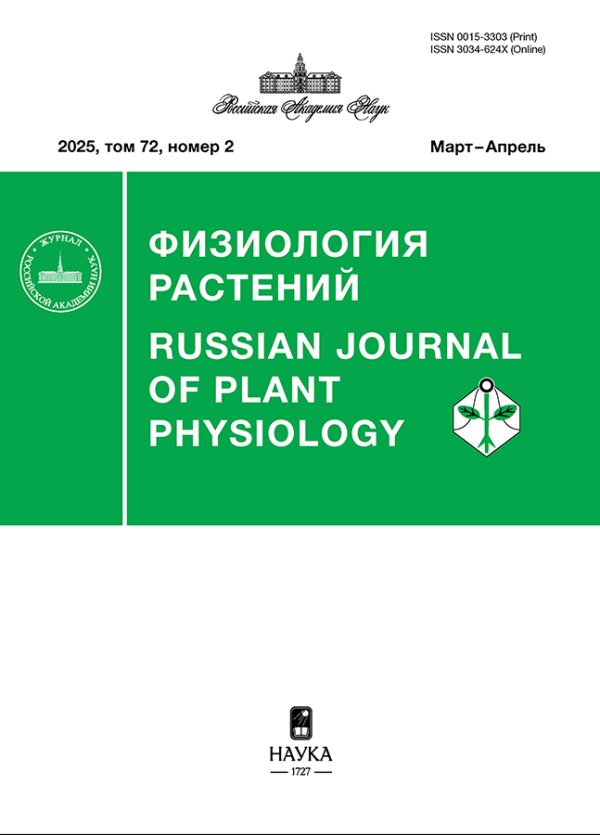Comparative Characteristics of Genes 9-Cis-Epoxycarotinoid-Dioxygenase SlNCED1 and SlNCED2 during the Development
- Authors: Efremov G.I.1, Ashikhmin A.A.2, Shchennikova A.V.1, Kochieva E.Z.1
-
Affiliations:
- Institute of Bioengineering, Federal Research Center Fundamentals of Biotechnology, Russian Academy of Sciences
- Institute for Fundamental Problems of Biology, Pushchino Scientific Center for Biological Research, Russian Academy of Sciences
- Issue: Vol 70, No 2 (2023)
- Pages: 171-180
- Section: ЭКСПЕРИМЕНТАЛЬНЫЕ СТАТЬИ
- URL: https://journals.rcsi.science/0015-3303/article/view/130198
- DOI: https://doi.org/10.31857/S0015330322600504
- EDN: https://elibrary.ru/GKUXSW
- ID: 130198
Cite item
Full Text
Abstract
Tomato Solanum lycopersicum L. is an important agricultural crop and, at the same time, a model for studying the ontogeny of the succulent fruit. The decisive role in the ripening of the fruit is played by abscisic acid, which is formed as a result of the oxidative cleavage of epoxycarotenoids 9-cis-epoxycarotenoid dioxygenases NCED. Gene-expression profiles of SlNCED1 and SlNCED2 and the content of carotenoids in fruits at different stages of development were determined in three varieties of tomato with different color of ripe fruit. It was shown that transcripts of both genes are present in all organs. Transcript level of SlNCED1 was approximately four to six times higher than the level of SlNCED2 transcripts; peak activity of SlNCED1 occurs in the late stages of ripening, while that of SlNCED2 is at the initial stage. Ripe fruits are characterized by the highest amount of carotenoids; lycopene was found only in the fruits of late stages in red-fruited varieties, the highest content of β-carotene was found in ripe fruits of the yellow-fruited variety. The precursor of abscisic acid, violaxanthin, is present only in the immature fruit; the other precursor, neoxanthin, decreases with ripening and is absent at the ripeness stage. In red-fruited varieties, a correlation was found between the level of SlNCED1 and SlNCED2 transcripts with the content of β-carotene. Findings suggest the coparticipation of SlNCED1 and SlNCED2 in the biosynthesis of abscisic acid during the development and ripening of tomato fruit. In this case, the key role belongs to the gene SlNCED1, the peak of activity of which falls on the stage of changing the color of the fruit. Lower levels of SINCED2 transcripts and its peak activity in the early stages of fruit development suggests a division of NCED functions between the two enzymes.
About the authors
G. I. Efremov
Institute of Bioengineering, Federal Research Center Fundamentals of Biotechnology, Russian Academy of Sciences
Email: gleb_efremov@mail.ru
Russian Federation, Moscow
A. A. Ashikhmin
Institute for Fundamental Problems of Biology, Pushchino Scientific Center for Biological Research, Russian Academy of Sciences
Email: gleb_efremov@mail.ru
Russian Federation, Pushchino
A. V. Shchennikova
Institute of Bioengineering, Federal Research Center Fundamentals of Biotechnology, Russian Academy of Sciences
Author for correspondence.
Email: gleb_efremov@mail.ru
Russian Federation, Moscow
E. Z. Kochieva
Institute of Bioengineering, Federal Research Center Fundamentals of Biotechnology, Russian Academy of Sciences
Email: gleb_efremov@mail.ru
Russian Federation, Moscow
References
- Li Y., Wang H., Zhang Y., Martin C. Can the world’s favorite fruit, tomato, provide an effective biosynthetic chassis for high-value metabolites? // Plant Cell Rep. 2018. V. 37. P. 1443. https://doi.org/10.1007/s00299-018-2283-8
- Peralta I.E., Spooner D.M. History, origin and early cultivation of tomato (Solanaceae) // Genetic improvement of Solanaceous crops. 2007. V. 2. P. 1.
- https://www.taylorfrancis.com/chapters/edit/10.1201/b10744-1/history-origin-early-cultivation-tomato-solanaceae-iris-peralta-david-spooner
- Slugina M.A. Transcription factor ripening inhibitor and its homologs in regulation of fleshy fruit ripening of various plant species // Russ. J. Plant Physiol. 2021. V. 68. P. 783. https://doi.org/10.1134/S1021443721050186
- Karlova R., Chapman N., David K., Angenent G.C., Seymour G.B., de Maagd R.A. Transcriptional control of fleshy fruit development and ripening // J. Exp. Bot. 2014. V. 65. P. 4527. https://doi.org/10.1093/jxb/eru316
- Kou X., Zhou J., Wu C.E., Yang S., Liu Y., Chai L., Xue Z. The interplay between ABA/ethylene and NAC TFs in tomato fruit ripening: a review // Plant Mol. Biol. 2021. V. 106. P. 223. https://doi.org/10.1007/s11103-021-01128-w
- Fenn M.A., Giovannoni J.J. Phytohormones in fruit development and maturation // Plant J. 2021. V. 105. P. 446. https://doi.org/10.1111/tpj.15112
- Osorio C.E. The role of orange gene in carotenoid accumulation: manipulating chromoplasts toward a colored future // Front. Plant Sci. 2019. V. 10. P. 1235. https://doi.org/10.3389/fpls.2019.01235
- Chattopadhyay T., Hazra P., Akhtar S., Maurya D., Mukherjee A., Roy S. Skin colour, carotenogenesis and chlorophyll degradation mutant alleles: genetic orchestration behind the fruit colour variation in tomato // Plant Cell Rep. 2021. V. 40. P. 767. https://doi.org/10.1007/s00299-020-02650-9
- López-Ráez J.A., Kohlen W., Charnikhova T., Mulder P., Undas A.K., Sergeant M.J., Verstappen F., Bugg T.D.H., Thompson A.J., Ruyter-Spira C., Bouwmeester H. Does abscisic acid affect strigolactone biosynthesis? // New Phytol. 2010. V. 187. P. 343. https://doi.org/10.1111/j.1469-8137.2010.03291.x
- Smolikova G.N., Medvedev S.S. Seed carotenoids: synthesis, diversity, and functions // Russ. J. Plant Physiol. 2015. V. 62. P. 1. https://doi.org/10.1134/S1021443715010136
- Wu H., Li H., Chen H., Qi Q., Ding Q., Xue J., Ding J., Jiang X., Hou X., Li Y. Identification and expression analysis of strigolactone biosynthetic and signaling genes reveal strigolactones are involved in fruit development of the woodland strawberry (Fragaria vesca) // BMC Plant Biol. 2019. V. 19. P. 73. https://doi.org/10.1186/s12870-019-1673-6
- Simkin A.J., Schwartz S.H., Auldridge M., Taylor M.G., Klee H.J. The tomato carotenoid cleavage dioxygenase 1 genes contribute to the formation of the flavor volatiles beta-ionone, pseudoionone, and geranylacetone // Plant J. 2004. V. 40. P. 882. https://doi.org/10.1111/j.1365-313X.2004.02263.x
- Kohlen W., Charnikhova T., Lammers M., Pollina T., Tóth P., Haider I., Pozo M.J., de Maagd R.A., Ruyter-Spira C., Bouwmeester H.J., López-Ráez J.A. The tomato CAROTENOID CLEAVAGE DIOXYGENASE8 (SlCCD8) regulates rhizosphere signaling, plant architecture and affects reproductive development through strigolactone biosynthesis // New Phytol. 2012. V. 196. P. 535. https://doi.org/10.1111/j.1469-8137.2012.04265.x
- Zhang M., Yuan B., Leng P. The role of ABA in triggering ethylene biosynthesis and ripening of tomato fruit // J. Exp. Bot. 2009. V. 60. P. 1579. https://doi.org/10.1093/jxb/erp026
- Wang P., Lu S., Zhang X., Hyden B., Qin L., Liu L., Bai Y., Han Y., Wen Z., Xu J., Cao H., Chen H. Double NCED isozymes control ABA biosynthesis for ripening and senescent regulation in peach fruits // Plant Sci. 2021. V. 304. P. 110739. https://doi.org/10.1016/j.plantsci.2020.110739
- Li C., Ma X., Huang X., Wang H., Wu H., Zhao M., Li J. Involvement of HD-ZIP I transcription factors LcHB2 and LcHB3 in fruitlet abscission by promoting transcription of genes related to the biosynthesis of ethylene and ABA in litchi // Tree Physiol. 2019. V. 39. P. 1600. https://doi.org/10.1093/treephys/tpz071
- Zhang M., Leng P., Zhang G., Li X. Cloning and functional analysis of 9-cis-epoxycarotenoid dioxygenase (NCED) genes encoding a key enzyme during abscisic acid biosynthesis from peach and grape fruits // J. Plant Physiol. 2009. V. 166. P. 1241. https://doi.org/10.1016/j.jplph.2009.01.013
- Kai W., Fu Y., Wang J., Liang B., Li Q., Leng P. Functional analysis of SlNCED1 in pistil development and fruit set in tomato (Solanum lycopersicum L.) // Sci Rep. 2019. V. 9. P. 16943. https://doi.org/10.1038/s41598-019-52948-2
- Martínez-Andújar C., Martínez-Pérez A., Ferrández-Ayela A., Albacete A., Martínez-Melgarejo P.A., Dodd I.C., Thompson A.J., Pérez-Pérez J.M., Pérez-Alfocea F. Impact of overexpression of 9-cis-epoxycarotenoid dioxygenase on growth and gene expression under salinity stress // Plant Sci. 2020. V. 295. P. 110268. https://doi.org/10.1016/j.plantsci.2019.110268
- Yang R., Yang T., Zhang H., Qi Y., Xing Y., Zhang N., Li R., Weeda S., Ren S., Ouyang B., Guo Y.D. Hormone profiling and transcription analysis reveal a major role of ABA in tomato salt tolerance // Plant Physiol. Biochem. 2014. V. 77. P. 23. https://doi.org/10.1016/j.plaphy.2014.01.015
- Sun L., Yuan B., Zhang M., Wang L., Cui M., Wang Q., Leng P. Fruit-specific RNAi-mediated suppression of SlNCED1 increases both lycopene and β-carotene contents in tomato fruit // J. Exp. Bot. 2012. V. 63. P. 3097. https://doi.org/10.1093/jxb/ers026
- Ntatsi G., Savvas D., Huntenburg K., Druege U., Hincha D.K., Zuther E., Schwarz D. A study on ABA involvement in the response of tomato to suboptimal root temperature using reciprocal grafts with notabilis, a null mutant in the ABA-biosynthesis gene LeNCED1 // Environ. Exp. Bot. 2014. V. 97. P. 11. https://doi.org/10.1016/j.envexpbot.2013.09.011
- Li X., Ahammed G.J., Zhang Y.Q., Zhang G.Q., Sun Z.H., Zhou J., Zhou Y.H., Xia X.J., Yu J.Q., Shi K. Carbon dioxide enrichment alleviates heat stress by improving cellular redox homeostasis through an ABA-independent process in tomato plants // Plant Biol (Stuttg). 2015. V. 17. P. 81. https://doi.org/10.1111/plb.12211
- Muñoz-Espinoza V.A., López-Climent M.F., Casaretto J.A., Gómez-Cadenas A. Water stress responses of tomato mutants impaired in hormone biosynthesis reveal abscisic acid, jasmonic acid and salicylic acid interactions // Front. Plant Sci. 2015. V. 6. P. 997. https://doi.org/10.3389/fpls.2015.00997
- Efremov G.I., Slugina M.A., Shchennikova A.V., Kochieva E.Z. Differential regulation of phytoene synthase PSY1 during fruit carotenogenesis in cultivated and wild tomato species (Solanum section Lycopersicon) // Plants. 2020. V. 9. P. 1169. https://doi.org/10.3390/plants9091169
- Filyushin M.A., Dzhos E.A., Shchennikova A.V., Kochieva E.Z. Dependence of pepper fruit colour on basic pigments ratio and expression pattern of carotenoid and anthocyanin biosynthesis genes // Russ. J. Plant Physiol. 2020. V. 67. P. 1054. https://doi.org/10.31857/S0015330320050048
- Ashikhmin A., Makhneva Z., Bolshakov M., Moskalenko A. Incorporation of spheroidene and spheroidenone into light-harvesting complexes from purple sulfur bacteria // J. Photochem. Photobiol. B, Biol. 2017. V. 170. P. 99. https://doi.org/10.1016/j.jphotobiol.2017.03.020
- Pashkovskiy P., Kreslavski V., Khudyakova A., Ashikhmin A., Bolshakov M., Kozhevnikova A., Kosobryukhov A., Kuznetsov V.V., Allakhverdiev S.I. Effect of high-intensity light on the photosynthetic activity, pigment content and expression of light-dependent genes of photomorphogenetic Solanum lycopersicum hp mutants // Plant Physiol. Biochem. 2021. V. 167. P. 91. https://doi.org/10.1016/j.plaphy.2021.07.033
- Tan B.C., Joseph L.M., Deng W.T., Liu L., Li Q.B., Cline K., McCarty D.R. Molecular characterization of the Arabidopsis 9-cis epoxycarotenoid dioxygenase gene family // Plant J. 2003. V. 35. P. 44. https://doi.org/10.1046/j.1365-313x.2003.01786.x
- Frey A., Effroy D., Lefebvre V., Seo M., Perreau F., Berger A., Sechet J., To A., North H.M., Marion-Poll A. Epoxycarotenoid cleavage by NCED5 fine-tunes ABA accumulation and affects seed dormancy and drought tolerance with other NCED family members // Plant J. 2012. V. 70. P. 501. https://doi.org/10.1111/j.1365-313X.2011.04887.x
- Behnam B., Iuchi S., Fujita M., Fujita Y., Takasaki H., Osakabe Y., Yamaguchi-Shinozaki K., Kobayashi M., Shinozaki K. Characterization of the promoter region of an Arabidopsis gene for 9-cis-epoxycarotenoid dioxygenase involved in dehydration-inducible transcription // DNA Res. 2013. V. 20. P. 315. https://doi.org/10.1093/dnares/dst012
- Wang P., Lu S., Zhang X., Hyden B., Qin L., Liu L., Bai Y., Han Y., Wen Z., Xu J., Cao H., Chen H. Double NCED isozymes control ABA biosynthesis for ripening and senescent regulation in peach fruits // Plant Sci. 2021. V. 304. P. 110739. https://doi.org/10.1016/j.plantsci.2020.110739
Supplementary files















